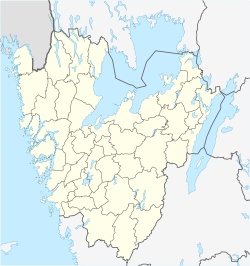Lödöse
| Lödöse | |
|---|---|

Museum of Lödöse
|
|
| Coordinates: 58°02′00″N 12°09′30″E / 58.03333°N 12.15833°ECoordinates: 58°02′00″N 12°09′30″E / 58.03333°N 12.15833°E | |
| Country | Sweden |
| Province | Västergötland |
| County | Västra Götaland County |
| Municipality | Lilla Edet Municipality |
| Area | |
| • Total | 1.28 km2 (0.49 sq mi) |
| Population (31 December 2010) | |
| • Total | 1,266 |
| • Density | 991/km2 (2,570/sq mi) |
| Time zone | CET (UTC+1) |
| • Summer (DST) | CEST (UTC+2) |
Lödöse, also known as Gamla Lödöse (Old Lödöse), Gamlöse or Gammelös, is a locality situated in Lilla Edet Municipality, Västra Götaland County, Sweden. A politically crucial centre of trade in the high middle ages, it had just 1,266 inhabitants in 2010. It is considered the precursor to modern-day Gothenburg, the second largest city in Sweden.
By the year 1000, Lödöse was an important trading town, located between modern-day Oslo and Copenhagen and near the mouth of the Göta river, the longest and largest river in Sweden. It was the Geats' only port on the west coast: hence, it had great strategic importance.
Trapped as it was between Norway and Denmark, Lödöse was moved further down the river to Nya Lödöse (New Lödöse), and eventually to the site of present-day Gothenburg, in order to escape taxes levied on merchants by the Norwegians at Bohus Fästning.
Today, Lödöse is a small town with 1,300 inhabitants in Lilla Edet Municipality, 40 kilometers northeast of Gothenburg up the Göta älv. The medieval history of the town is displayed at the prize-winning Middle Age museum – Lödöse Museum – which opened 1996.
...
Wikipedia


